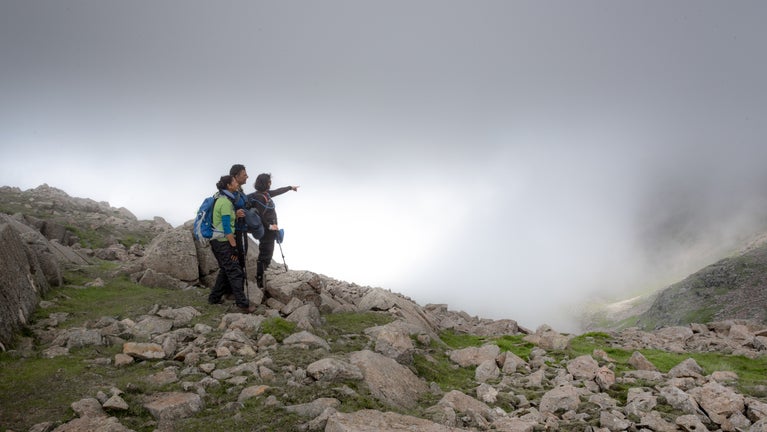
Discover more at Borrowdale and Derwent Water
Find out how to get to Borrowdale and Derwent Water, where to park, the things to see and do and more.

Standing at 978 metres tall, Scafell Pike is England's highest mountain and war memorial. Thousands of people enjoy Scafell Pike each year, however the climb to the top should not be underestimated and preparation is key to a great day out.
There are many different car parks to choose from in Borrowdale but if you are preparing to attempt the hike up Scafell Pike, we recommend parking at Seatoller.
There you will find one of the few toilette blocks in the valley, kept clean by our dedicated team.
You can find more information on fees and directions here.
Help us keep the area safe while looking after local farmer's livelihoods by not parking on roadsides. This is a very popular area and roads can sometimes get blocked, making it difficult for tractors and emergency vehicles to pass.

Whichever route you take, Scafell Pike is a tough, steep hike which involves scrambling over hard terrain. There will be challenges in any season: you might be met with high winds, rain, snow, extreme cold or poor visibility. Preparation is key to climbing safely, minimise your chance of getting lost or hurt and enjoy an exhilarating day out by following these safety tips.
Plan your route in advance and choose walking routes with your group’s capabilities and timings in mind. Follow pathways, avoiding cliff edges or walking on terrain that you are unsure of. You can download our trail guide here.
Glorious sunshine? Take a hat and some sun cream. Torrential rain? Consider whether the conditions are suitable based on you and your companion’s capabilities. Remember that warm and sunny conditions at the base can turn to cold, wet and windy conditions at the summit. You can find the weather forecast here.
When out exploring with others, it’s important to walk at the pace of the slowest person in your group. If you’d rather go alone, make sure to let someone know your plans before starting your journey. This should include your route, your start and finish points, estimated time of return and also any changes during your trip.
Choosing appropriate clothing for your activity is important when tackling the elements. Consider the right footwear, such as walking boots with ankle support, think about insulating layers, waterproofs and hats and gloves when facing challenging climbs, even in the summer.
A map and a compass is a good place to start and should be easily accessible if going on long walks or mountain climbs. You can find these available to borrow at Lake Head car park. Other useful items can include a watch, a torch with spare batteries and bulbs, a fully charged mobile phone, GPS and a whistle. This can be used to signal rescue with six good long blasts, stop for one minute, and then repeat until someone reaches you.
Before heading out, make sure you eat well. Carry food and plenty of drink to keep you hydrated and bring your energy levels up when needed. Chocolate and dried fruit are a great way to give you that quick boost.
Be aware of your surroundings and changes in weather conditions. Keep an eye on any children and pets joining you on your trip and be prepared for the possibility of having to turn back on your journey if the weather deteriorates.
Remember, if you find someone in trouble, don’t put yourself at risk. In an emergency, call 999 for help and ask for the police and then Mountain Rescue
The rangers work with Fix the Fells throughout the year to maintain fell paths and care for the fragile montane habitat, however it is vital that you take personal responsibility for your own safety.
Visit the Wasdale Mountain Rescue site and Adventure Smart for more tips on how to prepare for your climb to the summit of Scafell Pike.
Around 250,000 people climb Scafell Pike each year and we’ve been seeing unprecedented numbers of hikers over recent years. The increase in visitors puts the local mountain rescue teams under extreme pressure.
We ask that you come back another time if the car park is full and endeavour to lift share – the valley road is very narrow and frequently busy.
Well-behaved dogs are welcome at Scafell Pike, and many will enjoy a long day out climbing as much as their humans. Do bear in mind that it is a long and tiring day across rocky terrain so climbing Scafell Pike is only suitable for dogs used to long walks in the fells.
If your dog isn’t used to the fells then it’s perhaps worth trying a few lower, introductory walks before trying Scafell Pike. Please follow local and seasonal guidance, and where livestock are grazing please keep dogs on leads. For safety please keep your dog on the lead in the car parks

Find out how to get to Borrowdale and Derwent Water, where to park, the things to see and do and more.

Help to look after National Trust places by observing a few simple guidelines during your visit and following the Countryside Code.

From conservation projects and protecting archaeological features to improving the experience of visitors or laying hedgerows, our work at this special place is rich and varied.

Discover the internationally significant ‘Atlantic oakwoods’ and Derwent Water which support a variety of rare species of plants and animals, including the red squirrel and vendace.
Find out more about the work we are doing to look after the Borrowdale Temperate Rainforest and why it has been declared a new National Nature Reserve.